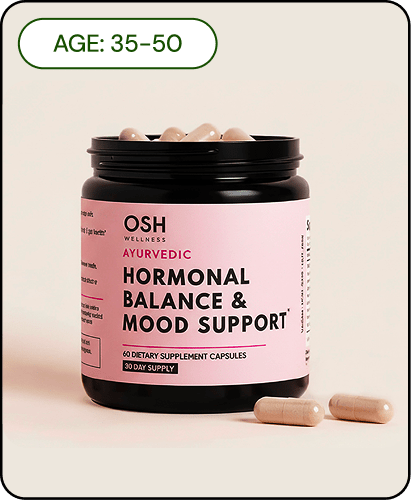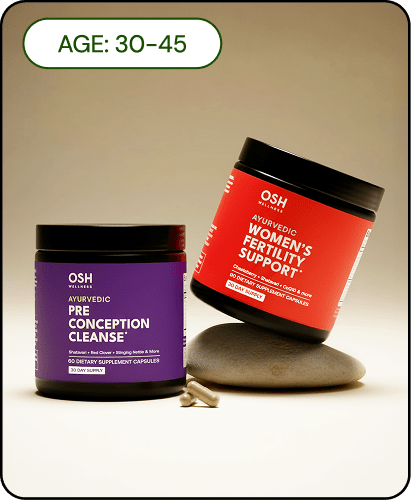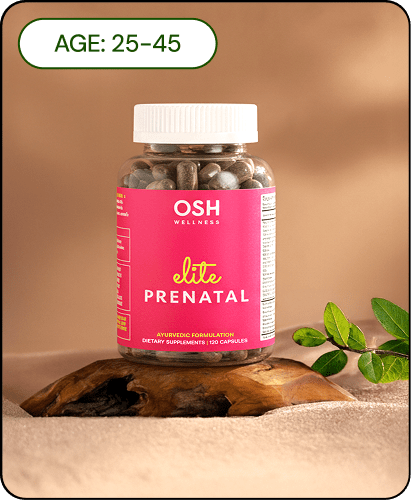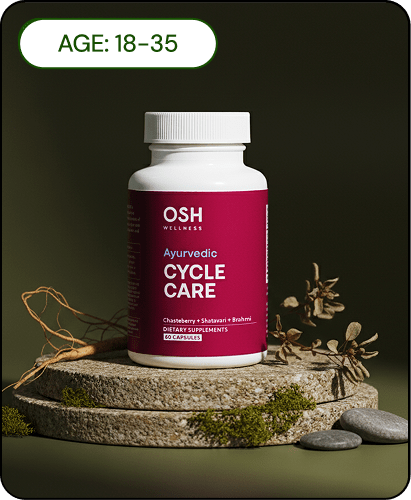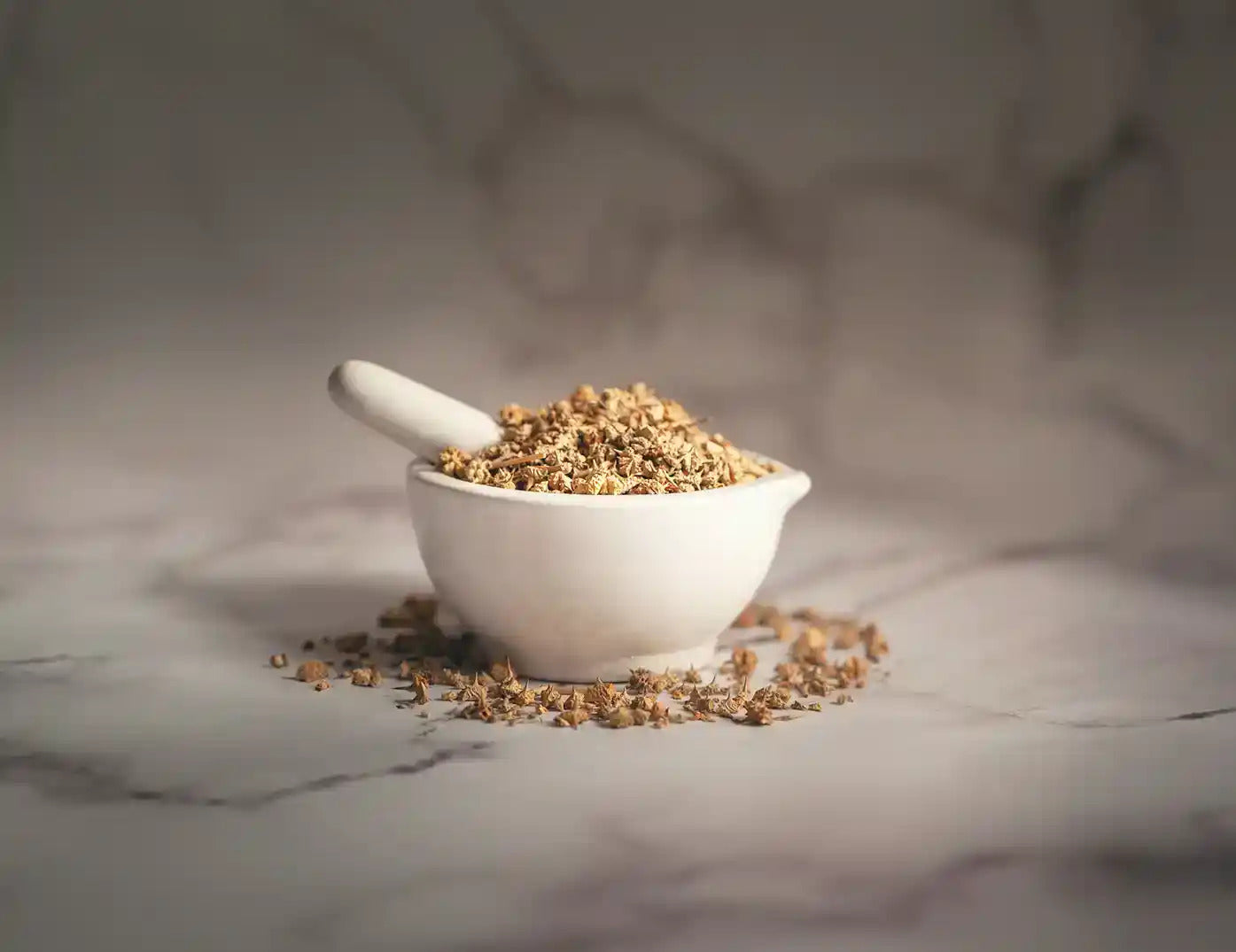Living with endometriosis can feel like navigating a maze without a map, painful periods that leave you bedridden, unexplained fertility struggles, and symptoms that doctors might dismiss as "normal women's problems." If you're among the estimated 10% of women worldwide battling this condition, you're not alone, and more importantly, you're not without options.
At Osh Wellness, we believe in empowering you with evidence-based approaches that help you find and try natural remedies before opting for conventional medical approaches. This comprehensive guide explores endometriosis from every angle, what causes it, how it affects your fertility, and the natural and medical interventions that can help you reclaim your quality of life.
What Is Endometriosis? Understanding the Condition That Affects Millions

Endometriosis occurs when tissue similar to the uterine lining (endometrium) grows outside the uterus , typically on the ovaries, fallopian tubes, and pelvic tissues. Unlike normal endometrial tissue that sheds during menstruation, this displaced tissue has nowhere to go, creating inflammation, scarring, and often debilitating pain.
The statistics paint a concerning picture: approximately 190 million women and girls globally suffer from endometriosis, yet diagnosis takes an average of 7-9 years [1]. This delay isn't just frustrating, it allows the condition to progress, potentially causing irreversible damage.
"Endometriosis isn't just 'bad periods', it's a whole-body inflammatory condition that can affect everything from your digestive system to your energy levels," explains Shruti Mishra, founder of Osh Wellness. "The sooner we identify it, the more options we have for managing it effectively."
Common symptoms include:
Severe menstrual cramps that don't respond to over-the-counter pain medication
Pain during or after sexual intercourse
Painful bowel movements or urination during periods
Heavy menstrual bleeding or bleeding between periods
Fatigue, diarrhea, constipation, or nausea during menstrual periods
Difficulty conceiving
If you recognize these symptoms, advocating for proper diagnostic testing, including transvaginal ultrasound, MRI, or laparoscopy, is crucial for receiving appropriate care.
The Complex Origins: What Causes Endometriosis?

Understanding endometriosis begins with recognizing that it's not caused by anything you did. Research points to several interconnected factors that contribute to this complex condition:
Retrograde Menstruation
The most widely accepted theory suggests that during menstruation, some blood and tissue flow backwards through the fallopian tubes into the pelvic cavity instead of leaving the body. While this happens to some degree in most women, those who develop endometriosis may have immune systems that fail to clear these misplaced cells [ 1 ].
Immune System Dysfunction
Your immune system might be playing a significant role in endometriosis development. Research shows women with the condition often have altered immune responses that fail to identify and destroy endometrial tissue growing outside the uterus. Some studies have found elevated levels of inflammatory markers like TNF-α and IL-6, which may promote lesion survival and growth [6].
Hormonal Imbalances
Estrogen dominance fuels endometriosis growth, while progesterone resistance prevents natural tissue regulation. This hormonal imbalance creates a perfect storm where lesions can establish their own blood supply and continue growing despite your body's attempts to regulate them [5].
Genetic Predisposition
If your mother, sister, or close female relatives have endometriosis, your risk increases significantly—by 7-10 times according to some studies. Researchers have identified several gene variants associated with endometriosis, particularly those involved in hormone metabolism, inflammation regulation, and tissue remodeling.
Understanding these root causes helps explain why endometriosis requires a multi-faceted approach to management—one that addresses inflammation, hormone balance, immune function, and pain regulation simultaneously.
How Endometriosis Impacts Your Hormones and Fertility

Endometriosis doesn't just cause pain, it creates a cascade of effects throughout your reproductive system that can significantly impact fertility. Here's what happens behind the scenes:
The Hormonal Hijacking
Endometriosis lesions aren't passive; they actively produce their own estrogen through an enzyme called aromatase. This creates a self-perpetuating cycle: more estrogen leads to more inflammation, which promotes more lesion growth, producing even more estrogen.
"It's like having tiny estrogen factories scattered throughout your pelvis," explains Ms. Mishra. "These lesions essentially create their own hormone supply, making them particularly difficult to manage."
This hormonal disruption can lead to:
Irregular ovulation or anovulation (no egg release)
Luteal phase defects that prevent proper implantation
Altered follicular development affecting egg quality
Progesterone resistance in the endometrium
The Fertility Connection
The link between endometriosis and fertility challenges is well-established:
Up to 50% of women with unexplained infertility are later diagnosed with endometriosis
30-50% of women with endometriosis struggle to conceive
Even with mild endometriosis, monthly fertility rates drop from the normal 15-20% to 2-10%
Multiple mechanisms contribute to these fertility challenges:
Anatomical Distortions: Adhesions and scar tissue can physically block the fallopian tubes or distort pelvic anatomy, preventing egg and sperm from meeting.
Inflammatory Environment : Elevated inflammatory cytokines damage sperm, eggs, and embryos while creating a hostile environment for implantation.
Impaired Implantation: Endometriosis alters the expression of important implantation markers like integrins and L-selectin ligands, making it harder for embryos to attach to the uterine lining.
Compromised Egg Quality: Inflammation and oxidative stress may damage eggs before they're even released.
Understanding these mechanisms helps explain why some women with endometriosis conceive easily while others face significant challenges—and why personalized treatment approaches are essential.
Nature's Medicine Cabinet: Herbs and Natural Remedies for Endometriosis Relief

While conventional treatments have their place, many women find significant relief through natural approaches that address inflammation, hormone balance, and pain management. Here's what research supports:
Powerful Herbal Allies
Red Clover : This phytoestrogen-rich herb may help modulate estrogen activity in the body. A clinical study showed red clover extract reduced endometrial thickness in postmenopausal women, suggesting potential benefits for endometriosis [2]. Its isoflavones compete with stronger estrogens for receptor sites, potentially helping balance hormonal activity [7].
Red clover provides gentler phytoestrogens that may help regulate estrogen dominance. However, women with estrogen-sensitive conditions should use it cautiously and always under professional guidance.
Shatavari (Asparagus racemosus): This Ayurvedic adaptogen has been used for centuries to support female reproductive health. Research indicates its anti-inflammatory properties may help reduce endometriosis-related inflammation while its adaptogenic effects help modulate stress hormones that can worsen symptoms [3].
A study found Shatavari extract reduced inflammatory markers and promoted immune cell activity that helped clear abnormal tissue growth in an animal model of endometriosis [8].
Moringa: Rich in antioxidants and anti-inflammatory compounds, moringa leaf extract has shown promising results in preliminary studies. Research published in the Journal of Medicinal Food demonstrated moringa extract reduced endometrial thickness and insulin-like growth factor 1 (IGF-1)—a compound linked to endometriosis lesion growth [4].
Chasteberry (Vitex): This hormone-balancing herb may help normalize progesterone levels, crucial for women with endometriosis who often experience progesterone resistance. Clinical studies show vitex can regulate menstrual cycles and reduce PMS symptoms, though research specific to endometriosis is still emerging [5].
Stinging Nettles: Rich in minerals like iron, calcium, and magnesium, stinging nettles help replenish nutrients often depleted during heavy menstrual bleeding. Its anti-inflammatory properties may also help reduce pain and inflammation associated with endometriosis. A study found that treatment with stinging nettle reduced the size of endometrial lesions in a rat model of endometriosis [9].
Chamomile: Chrysin, a flavonoid in chamomile, can help reduce Endo symptoms by inhibiting endometrial cell proliferation and NF-κB signaling [15].
Ginger: Ginger can reduce prostaglandin synthesis, easing painful periods. It is also known to lessen the severity of other menstrual-related symptoms.
Anti-Inflammatory Nutrition
Dietary changes can significantly impact endometriosis symptoms:
Omega-3 fatty acids: Found in fatty fish, flaxseeds, and walnuts, these essential fats help counteract the inflammatory prostaglandins that drive endometriosis pain [6].
Turmeric with black pepper: Curcumin, the active compound in turmeric, has been shown to inhibit endometrial cell proliferation and reduce inflammatory markers. One study found it suppressed the growth of endometrial cells by modulating estrogen signaling [6].
Cruciferous vegetables: Broccoli, cauliflower, and Brussels sprouts contain compounds that help the body metabolize estrogen more efficiently.
Antioxidant-rich foods: Colorful fruits and vegetables combat the oxidative stress that contributes to endometriosis progression.
"What you eat directly impacts inflammation levels and estrogen metabolism," explains Ms. Mishra who is also a certified nutritionist. "Many women see significant symptom improvement within 2-3 menstrual cycles of adopting an anti-inflammatory diet."
Pairing up Osh Wellness Pre-Conception Cleanse with Golden Latte can be an effective natural remedy to try, and it contains many of these natural ingredients that can reduce Endometriosis symptoms.*
Mind-Body Approaches
The connection between stress and endometriosis symptoms is well-documented:
Yoga : A randomized controlled trial found women practicing yoga twice weekly experienced a 40% reduction in pelvic pain after 8 weeks.
Acupuncture : Multiple studies show acupuncture reduces endometriosis pain by stimulating endorphin release and improving pelvic blood flow. A 2018 systematic review demonstrated that acupuncture showed significantly improved outcomes compared to other complementary therapies for endometriosis symptoms [10].
Mindfulness meditation : Regular practice reduces stress hormones that can trigger flares and worsen pain perception.
These natural approaches work best as part of an integrated strategy, complementing rather than replacing conventional treatments when needed.
Pregnancy and Endometriosis: Navigating the Fertility Journey

One of the most heartbreaking aspects of endometriosis is its impact on fertility—but there's much more hope than many women realize. Let's explore the realities of conception with endometriosis and strategies to improve your chances:
Can You Get Pregnant with Endometriosis?
The short answer is yes—many women with endometriosis successfully conceive and carry healthy pregnancies. However, the journey may require more planning and possibly medical intervention:
With mild endometriosis, about 70-80% of women conceive naturally within 3 years
Moderate to severe cases may reduce monthly fertility rates from the normal 15-20% down to 2-10%
Even with advanced endometriosis, pregnancy is possible with appropriate treatment
"The key is understanding that endometriosis exists on a spectrum," explains Ms. Mishra. "Some women conceive easily despite extensive lesions, while others with minimal disease face significant challenges. Each case is unique."
Strategic Approaches to Conception
If you're trying to conceive with endometriosis, consider these evidence-based strategies:
Timing Is Everything : Some research suggests trying to conceive soon after surgical removal of endometriosis lesions, when fertility rates temporarily improve. Working with a fertility awareness practitioner to identify your most fertile days can maximize your chances.
Fertility Preservation : If you're not ready for pregnancy but concerned about future fertility, discuss egg freezing options with your doctor, especially if you're facing surgery or treatments that might affect ovarian function.
Assisted Reproductive Technologies : For moderate to severe cases, intrauterine insemination (IUI) or in vitro fertilization (IVF) may be recommended. Success rates with IVF range from 20-40% per cycle for women with endometriosis, depending on age and disease severity [11].
Pregnancy Effects on Endometriosis
Interestingly, pregnancy often provides temporary relief from endometriosis symptoms due to:
High progesterone levels that suppress lesion growth
Absence of menstrual cycles that would normally stimulate lesions
Immune system changes that may help regulate inflammation
"Many women experience nine months of symptom relief during pregnancy," notes Ms. Mishra. "However, it's important to understand that pregnancy doesn't cure endometriosis—symptoms typically return after delivery and breastfeeding."
Special Considerations for Pregnancy
If you have endometriosis and become pregnant, be aware of these important considerations:
Higher risk of complications: Research shows a slightly increased risk of preterm birth, placenta previa, and cesarean delivery [1]
Specialized prenatal care: Working with a high-risk obstetrician familiar with endometriosis is advisable
Postpartum planning: Discuss options for managing symptoms after delivery, especially if breastfeeding (which may continue to suppress symptoms)
With proper planning and care, most women with endometriosis have healthy pregnancies and deliveries —another reason why early diagnosis and treatment are so valuable.
Medical Treatments: When to Consider Conventional Approaches

While natural remedies provide significant benefits for many women, conventional medical treatments play an important role in comprehensive endometriosis management. Understanding your options helps you make informed decisions about when to incorporate these approaches:
First-Line Treatments
Hormonal Contraceptives : Combined oral contraceptives or progestin-only options reduce pain by suppressing ovulation and thinning the endometrium. Studies show they reduce pain by 60-80% in many women.
Nonsteroidal Anti-inflammatory Drugs (NSAIDs) : These medications directly target the prostaglandins that cause inflammation and pain. For maximum effectiveness, start taking them 1-2 days before your period begins.
Advanced Medical Options
For more severe cases or when first-line treatments aren't sufficient:
GnRH Agonists and Antagonists : These medications create a temporary menopausal state, dramatically reducing estrogen and halting endometriosis progression. They're typically used for 3-6 months before fertility treatments or to provide a "treatment break" when symptoms are severe.
Aromatase Inhibitors : These specialized medications block the production of estrogen in endometriosis lesions themselves—addressing the source of the problem. They're particularly useful for cases that don't respond to other treatments.
Laparoscopic Surgery: The gold standard for both diagnosis and treatment, laparoscopic excision removes endometriosis lesions while preserving healthy tissue. Research shows a 40-60% reduction in pain following expert excision surgery, with effects lasting several years in many cases.
When to Consider Medical Intervention
Consider conventional treatments when:
Pain significantly impacts your quality of life despite natural approaches
You're actively trying to conceive without success
Imaging shows endometriomas (ovarian cysts) or deep infiltrating endometriosis
You experience organ dysfunction (such as bowel or bladder problems)
Natural approaches haven't provided sufficient relief after 3-6 months
"The most effective approach is often integrative—combining the best of conventional medicine with evidence-based natural remedies," explains integrative gynecologist Dr. Amina Patel. "This provides immediate symptom relief while addressing the underlying inflammatory and hormonal imbalances."
Living Well with Endometriosis: Your Action Plan

Managing endometriosis is a marathon, not a sprint. Here's a practical action plan to help you take control of your health journey:
Step 1: Get Properly Diagnosed
If you suspect endometriosis but lack a formal diagnosis:
Track your symptoms using a period-tracking app with symptom logging
Request a referral to a gynecologist experienced with endometriosis
Consider transvaginal ultrasound, MRI, or diagnostic laparoscopy
Join support groups like Endometriosis Foundation of America or Nancy's Nook for resources
Step 2: Assemble Your Wellness Team
Effective management typically requires multiple perspectives:
Gynecologist or reproductive endocrinologist
Integrative or functional medicine practitioner
Nutritionist familiar with anti-inflammatory protocols
Physical therapist specializing in pelvic floor dysfunction
Mental health professional for pain management strategies
Step 3: Implement Your Daily Management Strategy
Morning Routine:
Anti-inflammatory breakfast (e.g., smoothie with berries, turmeric, and ground flaxseed, Osh Wellness Golden Latte)
Gentle movements like yoga or walking
Stress management practice (meditation, deep breathing)
Throughout the Day:
Stay hydrated with anti-inflammatory teas like ginger or peppermint
-
Take scheduled supplements (discuss with your healthcare provider):
Omega-3 fatty acids: 1000-2000mg daily
Turmeric/curcumin: through Golden Latte
Herbal support: Pre-Conception Cleanse
Vitamin D: 2000-5000 IU based on blood levels
Magnesium: 300-400mg for muscle relaxation and pain
Evening Wind-Down:
Apply heat therapy to painful areas
Practice gentle stretching
Use castor oil packs on lower abdomen (except during menstruation)
Journal about symptoms, triggers, and improvements
Step 4: Prepare for Flare Management
Create a flare kit containing:
Prescription or over-the-counter pain medication
Heat therapy options (heating pad, hot water bottle)
Essential oils for massage (lavender, clary sage)
Comfort items (comfortable clothes, favorite tea)
Contact information for your healthcare team
"The key to living well with endometriosis is proactive management rather than crisis response," advises health coach Maria Sanchez, who has lived with endometriosis for 15 years. "On good days, build your resilience through anti-inflammatory nutrition and stress management. On difficult days, be gentle with yourself and use all the tools in your toolkit."
Embracing Your Endometriosis Journey
Living with endometriosis requires patience, self-advocacy, and a willingness to explore multiple healing modalities—from evidence-based herbs like red clover and shatavari to conventional medical interventions when needed. While the path isn't always straightforward, combining anti-inflammatory nutrition, stress management, and targeted supplements with appropriate medical care offers the best chance for symptom relief and fertility support. Remember that each woman's experience with endometriosis is unique, and finding your personal balance of treatments may take time and experimentation.
FAQ
Can endometriosis go away on its own?
Endometriosis is a chronic condition that typically doesn't resolve without intervention. However, symptoms may fluctuate in severity throughout your life, particularly during pregnancy and after menopause when hormonal changes occur. Comprehensive management approaches can significantly reduce symptoms and slow progression.
Are herbal remedies safe to use alongside conventional endometriosis treatments?
Many herbs can be safely used alongside conventional treatments, but some may interact with medications or have contraindications. Always consult with a healthcare provider knowledgeable about herb-drug interactions before combining approaches.
How can I tell if my endometriosis is affecting my fertility?
If you've been trying to conceive for 6-12 months without success (depending on your age), endometriosis may be a factor. Diagnostic tests like transvaginal ultrasound, anti-Müllerian hormone (AMH) testing, or laparoscopy can help assess the impact on your reproductive organs. Working with a reproductive endocrinologist is recommended if you have known endometriosis and are trying to conceive.
Can dietary changes really make a difference with endometriosis symptoms?
Research increasingly supports the role of anti-inflammatory nutrition in managing endometriosis. A study found women following Mediterranean-style diets rich in fruits, vegetables, and omega-3s reported significant pain relief compared to those eating standard Western diets high in processed foods. Dietary changes typically show benefits within 2-3 menstrual cycles.

